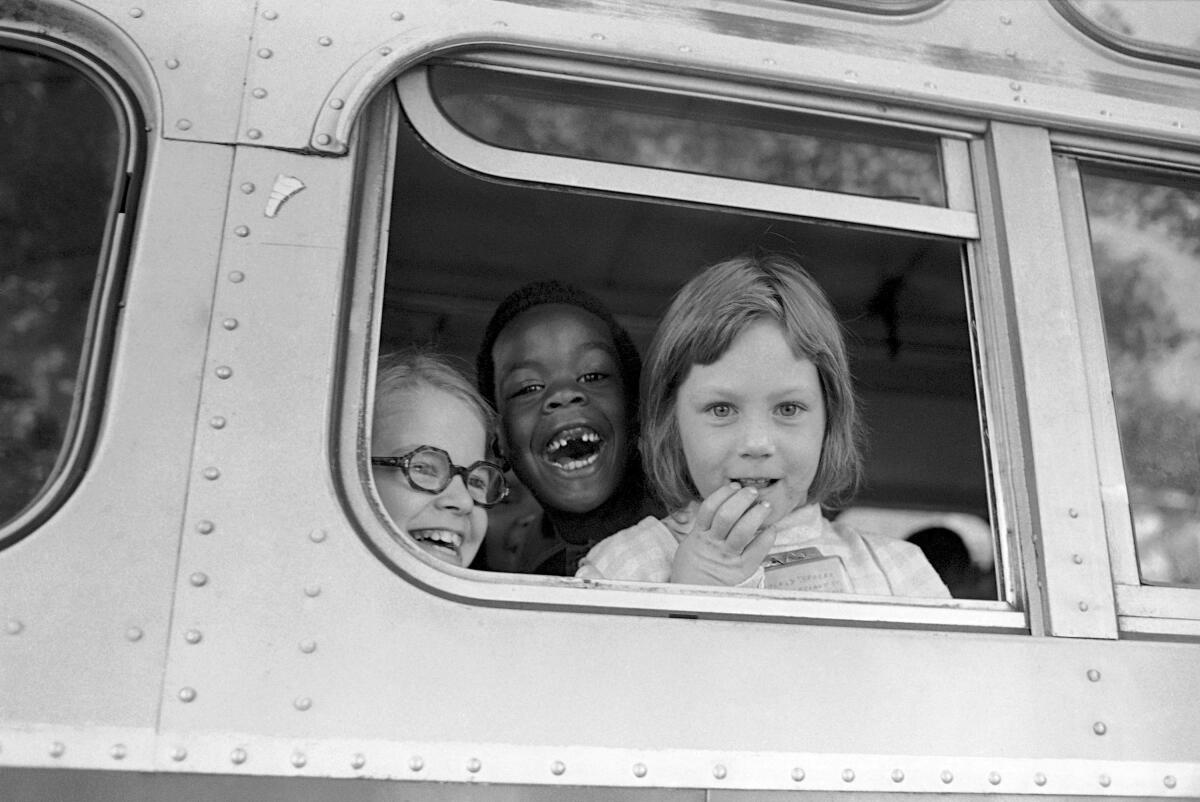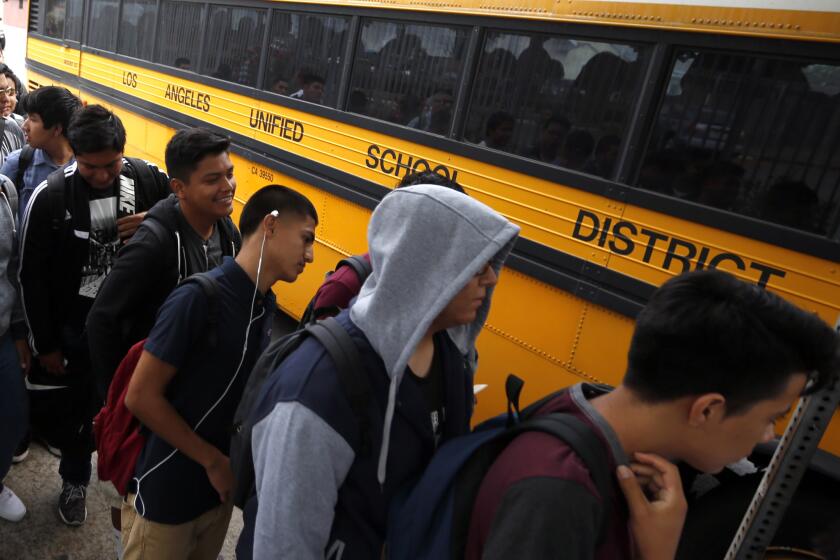70 years ago, school integration was a dream many believed could actually happen. It hasn’t

WASHINGTON — Seventy years ago this week, the U.S. Supreme Court ruled separating children in schools by race was unconstitutional. On paper, that decision — the fabled Brown vs. Board of Education, widely taught in American classrooms — still stands.
But for decades, American schools have been resegregating. The country is more diverse than it ever has been, with students more exposed to classmates from different backgrounds. Still, around 4 out of 10 Black and Latino students attend schools where almost every one of their classmates is another student of color.
The intense segregation by race is linked to socioeconomic conditions: Schools where students of color make up more than 90% of the student body are five times more likely to be in low-income areas. That in turn has resounding academic consequences: Students who attend high-poverty schools, regardless of their family’s finances, have worse educational outcomes.
Efforts to slow or reverse the increasing separation of American schools have stalled. Court cases slowly have chipped away at the dream outlined in Brown vs. Board, leaving fewer and fewer tools in the hands of districts to integrate schools by the early 2000s.
The arc of the moral universe, in this case, does not seem to be bending toward justice.
“School integration exists as little more than an idea in America right now, a little more than a memory,” said Derek Black, a law professor at USC. “It’s actually an idea that a pretty good majority of Americans think is a good idea. But that’s all.”
Nearly 50 years have passed since Kamala Harris joined the legions of children bused to schools in distant neighborhoods as the United States attempted to integrate its racially segregated public schools.
More than just diverse schools
The dream of Brown was never as simple as diversity. It was about equality, and the opportunity that came with it.
From the beginning, funding and integration have been inseparable.
“Whiter schools and districts have more resources, and that is wrong,” said Ary Amerikaner, a former Obama administration official and the founder of the organization Brown’s Promise. “But it is a reality. And that undermines opportunity for students of color, and it undermines our future democracy.”
We remember Brown vs. Board as the end of segregated schools in the United States. But stating values does not, alone, change reality. Though the case was decided in 1954, it was followed by more than a decade of delay and avoidance before school districts began to meaningfully allow Black students to enter previously white schools.
It took further court rulings, monitoring and enforcement to bring a short-lived era of integration to hundreds of school districts. For the students who took part in those desegregation programs, their life trajectory changed — the more years spent in integrated schools, the better Black children fared on measures such as educational attainment, graduation rates, health and earning potential, with no adverse effects on white children.
For a brief period, it seemed the country recognized the deeper remedies required. “All things being equal, with no history of discrimination, it might well be desirable to assign pupils to schools nearest their homes,” Chief Justice Warren Burger wrote in Swann vs. Mecklenburg, a 1971 decision that upheld the use of busing to integrate schools in North Carolina. “But all things are not equal in a system that has been deliberately constructed and maintained to enforce racial segregation.”
Local family’s court fight not only led to equality in O.C. schools but also paved the way for change nationwide.
But not long after, another series of court decisions would unwind those outcomes. Fifty years ago, in Milliken vs. Bradley, the court struck down a plan for integrating Detroit public schools across school district lines. The ruling undermined desegregation efforts in the North and Midwest, where small districts allowed white families to escape integration.
Other decisions followed. In Freeman vs. Pitts, the court ruled resegregation from private choice and demographic shifts could not be monitored by the court. More than 200 districts were released from court-monitored desegregation plans. By 2007, when the court ruled in Parents Involved in Community Schools vs. Seattle School District No. 1, even voluntary integration plans could no longer consider assigning students on the basis of race.
“If you have the tools taken away from you ... by the Supreme Court, then you really don’t have a whole lot of tools,” said Stephan Blanford, a former Seattle school board member.
One district as a microcosm
The arc of history is clear in the city where the landmark Swann busing case originated.
At its peak, Charlotte-Mecklenburg Schools was considered such a success at integrating classrooms and closing the gap between Black and white students that educators around the country came to tour the district. Today, more than 20 years after a court ruling overturned busing students on the basis of race, CMS is the most segregated district in North Carolina.
Though there are no laws that keep kids divided by race and income, in so many schools that is the reality.
Charlotte’s sprawling busing plan brought Black and white students into the same schools — and, by extension, made white children’s resources available to Black students for the first time. The district’s integration program ended when white families sued after their children did not get their top choice of school placement in a lottery that considered race.
U.S. Senate passes legislation to turn a formerly segregated “Mexican” school in west Texas into a historic site.
Instead, the district created a school assignment process that said diversity “will be based on the family’s decisions.” It left the families of Mecklenburg County, some of whom have always had better choices than others, on their own. In the first year of the district’s choice program, Black families were more likely to try to use the choice plan to pick an alternative school. They were also more likely to get none of the magnet schools they wanted.
In the decades that followed, the district resegregated. Years of busing had unwound the segregated makeup of the schools, but the underlying disparities and residential segregation had been left untouched.
Charlotte is a place where the divide between affluence and poverty, and the clear racial lines that mirror it, are so stark that people who live there refer to the city in two parts — the well-off “wedge” and the poorer “crescent.” How could anything other than an explicit consideration of those conditions ever hope to ameliorate them?
Solutions to segregated schools exist in this context, often relying on individual families to make choices that are limited by their circumstances. Magnet schools and inter-district transfers — two common policies that may create great individual opportunities — are limited and will always leave some students behind.
Wherever you look, families are divided in how they view integration. For white and affluent families, it can exist as a noble idea, one filled with self-reflection. But for families of color or poor families — those with less of a safety net — the point of integration often is to place their children somewhere better.
Efforts to integrate schools can take two paths, said Stefan Lallinger, executive director of Next100, a public policy think tank. They either fight around the margins, creating slightly less segregated spaces, or they address the problem head-on, which in many parts of the country would mean tackling boundaries deliberately drawn to separate rich from poor.
A once-segregated Mexican American school in Texas may become a historic site.
How to move forward in a system that resists
Amerikaner and Saba Bireda founded Brown’s Promise on the idea of bridging the divide between funding and integration, leveraging state courts to obtain the tools the Supreme Court has taken away from districts.
Their strategy has some precedence. In Connecticut, a 1989 lawsuit in state court resulted in the creation of an inter-district transfer program, which allows students in Hartford to transfer into suburban schools and magnet programs, breaking up concentrations of poverty and racially isolated schools.
“This country had to be moved to integration,” Bireda said. “And unfortunately, 70 years later, we feel like we still need litigation. We need the push of the courts.”
More recent lawsuits have taken place in New Jersey and Minnesota. In 2015, Alex Cruz-Guzman became a plaintiff in a suit challenging segregation in Minneapolis and St. Paul public schools. Cruz-Guzman immigrated to the U.S. from Mexico as a teenager. As a parent, he noticed his children’s schools consisted almost entirely of other Latino students. When he tried to place them in more integrated schools, the family faced long wait lists.
The case wound its way through court for nearly a decade, almost reaching a settlement in the state Legislature, but that bill failed to pass.
After real estate agents invented racial covenants in the early 1900s, L.A. led the nation in using them. Their idea of ‘freedom’ shapes the U.S. today.
Cruz-Guzman recalls people asking him why he would join a case that probably would not be resolved in time to benefit his own children, who struggled with learning English for a time in predominantly Latino schools. To him, the arc of the case is about the kids whose lives could change in the future. “It’s not only my kids. My grandkids will benefit from it,” he said. “People for generations will benefit.”
How far those legal cases can reach remains to be seen. Actual solutions are imperfect. But integration is something this country has tried before, and while it lasted, by many measures, it worked.
Anniversaries are moments to stop and contemplate. Seventy years after Brown, the work toward achieving its vision remains unfinished. Though there are no perfect, easy answers, what other choice is there besides trying imperfect pathways to bring about an increasingly diverse country somewhere closer to the promise of Brown?
“What’s the alternative?” Bireda said. “We are headed toward a country that is going to be majority people of color. ... We can be a strong multiracial democracy, but we cannot be that if we continue to allow most children in the United States not to go to school with children who are from different backgrounds.”
Ma writes for the Associated Press.
More to Read
Sign up for Essential California
The most important California stories and recommendations in your inbox every morning.
You may occasionally receive promotional content from the Los Angeles Times.














